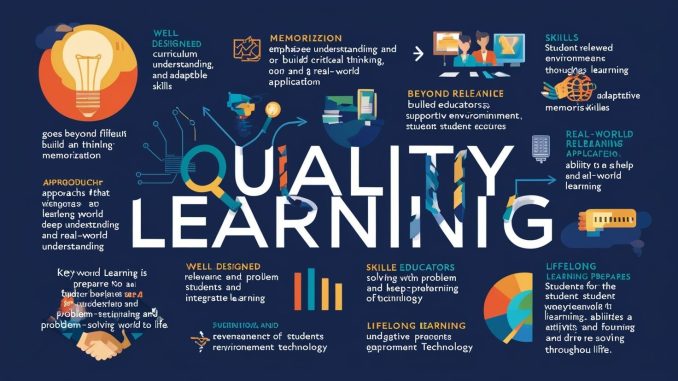
For generations, education has often been equated with memorization. Students have been praised for their ability to recall dates, formulas, and definitions with speed and accuracy, as if the act of storing information itself was the pinnacle of learning. While memorization has its place, relying on it as the primary measure of understanding creates shallow knowledge that rarely lasts beyond the next test or presentation. In contrast, deep understanding goes further—it involves the ability to connect ideas, apply concepts to new situations, and critically evaluate information. In a world where information is abundant and easily accessible, it is deep understanding, not rote recall, that equips individuals to thrive in both academic and professional environments.
The limitations of memorization become especially clear in practice. A student may memorize the steps of a mathematical formula but struggle when the problem is presented in a slightly different format. An employee may recall a company policy word-for-word but fail to adapt it to a unique client situation. These examples illustrate how memorization alone often collapses when confronted with complexity. Deep understanding, on the other hand, prepares individuals to adapt. When someone truly grasps the principles behind a formula, they can apply it flexibly to a variety of problems. When they understand the reasoning behind a policy, they can interpret it with judgment, balancing guidelines with context. The difference lies in whether knowledge is surface-level or integrated into a framework that can be used creatively.
Deep understanding develops when learners engage actively with material rather than passively absorbing it. This means asking questions, exploring relationships, and challenging assumptions. Consider how history can be taught: one approach requires students to memorize dates and names, while another encourages them to analyze causes, consequences, and perspectives. The latter not only helps students remember the facts more naturally but also allows them to draw parallels to contemporary events, building a richer comprehension of how patterns in human behavior repeat over time. In business, this same principle applies when professionals analyze case studies or simulations rather than simply reading manuals. They learn not just what happened but why it happened, equipping them to make informed decisions in real-world scenarios.
One of the greatest strengths of deep understanding is its role in problem-solving. Modern challenges—whether in education, business, or society—rarely present themselves in the same way as examples in a textbook. They are complex, dynamic, and often ambiguous. Memorization may provide a starting point, but it cannot account for all the nuances. A marketing professional who memorizes demographic data might miss the underlying trends that drive consumer behavior. But one who understands those trends can anticipate shifts, adapt strategies, and seize opportunities before competitors. Deep understanding enables agility, allowing individuals to transfer knowledge across contexts rather than being confined to narrow applications.
The rise of technology has amplified the importance of moving beyond memorization. With a few clicks, anyone can access information that once required hours of study. Facts are no longer scarce; they are ubiquitous. What matters now is not how much information one can recall, but how effectively one can interpret, analyze, and apply it. This shift has significant implications for education and business training. In classrooms, the emphasis must be less on drilling students to repeat answers and more on cultivating skills that help them make sense of the information they encounter. In organizations, professional development must prioritize critical thinking, creativity, and adaptability over rote knowledge that can quickly become outdated.
Deep understanding also fosters engagement and motivation. Memorization often feels mechanical, a task to complete rather than an experience to enjoy. Learners may push through it out of obligation, but they rarely develop a passion for the subject. By contrast, when individuals see connections between what they are learning and their lives or work, their interest grows. A student who understands the logic behind a scientific principle may begin to see the world differently, noticing patterns in nature or technology. An employee who understands the broader strategy behind a business initiative feels more invested in contributing to its success. Understanding fuels curiosity, and curiosity fuels ongoing learning—a cycle that sustains growth long after formal education ends.
Feedback plays a crucial role in moving from memorization to understanding. Simply rewarding correct answers reinforces recall, but meaningful feedback encourages learners to think deeper about their reasoning. When a mentor or manager asks, “Why do you think this works?” or “How would you approach it differently in another situation?” they push learners to articulate connections and explore alternatives. These reflective questions transform knowledge from something static into something dynamic, helping learners refine their thinking and internalize concepts at a deeper level. Over time, this approach builds confidence in applying knowledge creatively rather than just repeating it.
The transition to deep understanding also requires a cultural shift in how success is measured. Traditional systems often reward short-term recall—grades, scores, and certifications serve as benchmarks of achievement. While these metrics have value, they do not always capture the depth of comprehension that drives long-term success. Businesses, too, can fall into the trap of valuing credentials over capability. The more effective approach is to assess performance in real-world contexts, where individuals must demonstrate adaptability, reasoning, and problem-solving. By valuing depth over surface, organizations and educators alike send the message that true learning is about more than memorizing facts—it is about cultivating wisdom.
Ultimately, moving beyond memorization to deep understanding is not about discarding facts but about embedding them into meaningful frameworks. Facts are the building blocks of knowledge, but without context, they are fragile and fleeting. When integrated into deeper structures of meaning, they become tools for innovation, collaboration, and growth. For individuals, this shift means developing the ability to think critically, apply knowledge flexibly, and continue learning throughout life. For organizations, it means fostering environments where curiosity is encouraged and where understanding is valued over mere compliance. In a world defined by complexity and change, it is deep understanding—not memorization—that enables people to navigate uncertainty with confidence and creativity.